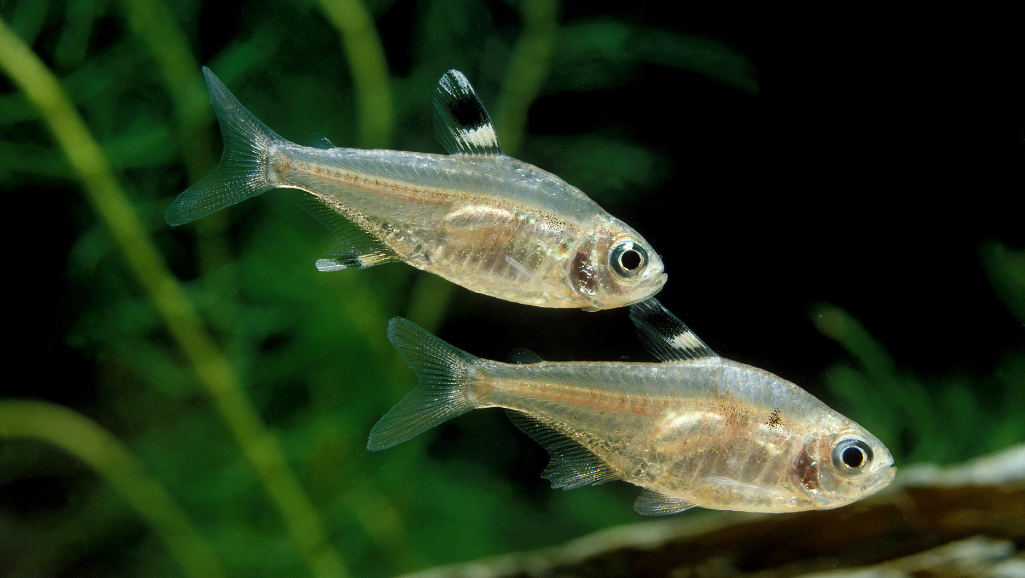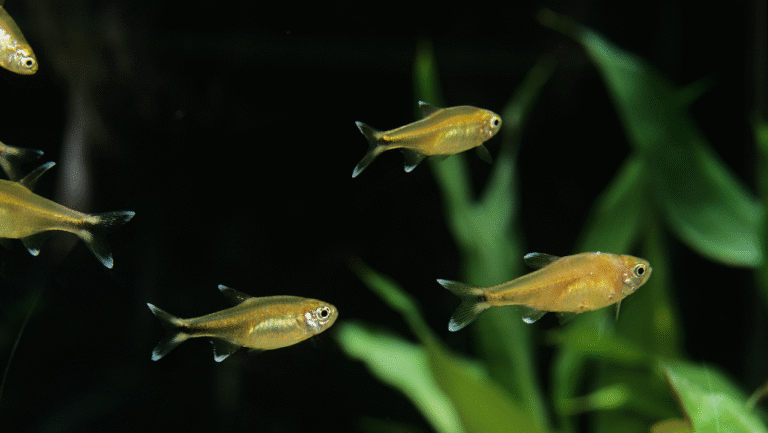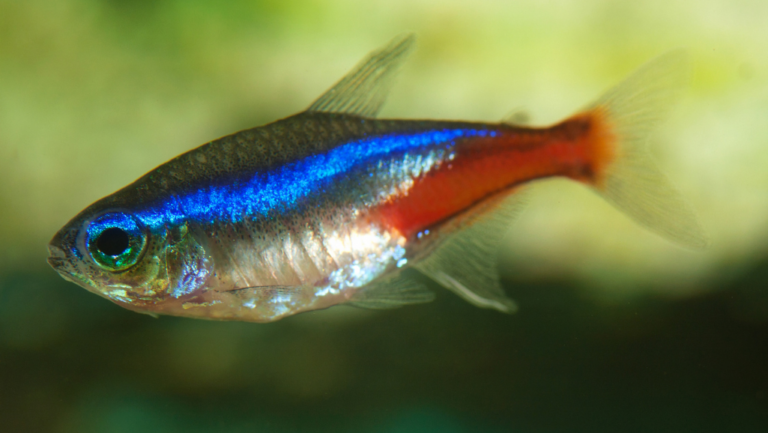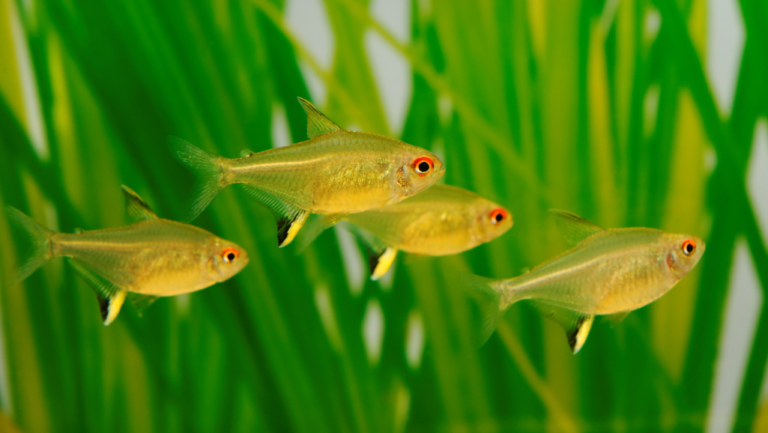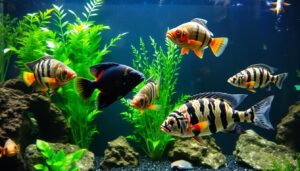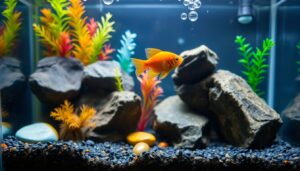Meet a vibrant, peaceful fish that brings copper-orange glow and a bold black lambchop mark to planted aquariums. This species wins hearts with its calm nature and bright color, making small tanks feel alive.
The common name links to Trigonostigma espei, so shoppers and hobbyists can spot it in stores and online. Keep a school of six or more for confident behavior and the best color.
In a well-planted aquarium, the fish swims mid to upper levels where its tones pop against green leaves. A 10-gallon tank fits a small group, but larger setups and live plants let this species thrive longer.
Practical care is simple: aim near 76°F, slightly acidic to neutral pH, soft water, a hang-on-back filter, and dechlorinated tap water. With steady conditions, life span ranges three to six years.
Key Takeaways
- Bright, peaceful species ideal for nature-style aquariums.
- Known as Trigonostigma espei; look for the lambchop-shaped mark.
- Keep in groups of six+ for color and Lambchop Rasbora.
- Prefer planted tanks, soft slightly acidic water, and steady filtration.
- 10-gallon minimum for small schools; larger is better for long life.
Meet Trigonostigma espei: What Makes This Rasbora Shine
Trigonostigma espei stands out with a tiny, burnished body and a signature dark wedge that stops short of the tail.
Quick ID: Size, color, and the “mark”
This species reaches about 1–1.5 inches in mature size. The body is slim and copper-red with a pale underbelly.
Fins are translucent and delicate. The black, wedge-shaped mark widens mid-body and ends before the caudal fin. Healthy fish show bright, burnished tones under soft light.
Spotting subtle differences vs. a close cousin
Compared with Trigonostigma heteromorpha, this fish is slimmer and more orange-toned. Harlequin relatives are deeper-bodied with a broader, darker triangular mark and a pinkish tint.
Sexing tip: females tend to appear fuller-bodied, while males often display crisper wedge edges. When choosing stock, prefer active, intact individuals with clear markings.
| Trait | Trigonostigma espei | Harlequin (T. heteromorpha) |
|---|---|---|
| Typical size | 1–1.5 inches | 1.2–1.8 inches |
| Body tone | Copper-red, brighter orange | Pinkish to copper |
| Flank mark | Narrow wedge, stops before tail | Broader, darker triangle |
| Profile | Slimmer, elegant | Deeper-bodied |
| Native range | Thailand, Cambodia | Southeast Asia broadly |
Tip: Remember the scientific name when researching care and sourcing to find reliable information and healthy stock.
How to Set Up the Ideal Aquarium Environment
Designing the right aquarium layout gives this species the stage it needs to school, display color, and feel secure. Start by planning swimming lanes and plant thickets so groups can move together without feeling exposed.
Tank size, open swimming space, and schooling needs
Start with a 10-gallon tank minimum for six fish, but aim for a 20-gallon aquarium or larger to unlock better swimming lanes and stable water. Open midwater corridors let the school pivot and show natural behavior. Keep groups of six or more for confidence and color.
Live plants and aquascape
Use a dark substrate with driftwood and rockwork to make copper tones pop. Ring open areas with planted thickets so the fish can dart between cover and open water.
Choose low-light plants like Anubias, Cryptocoryne, and Taxiphyllum attached to hardscape for layered depth with low maintenance.
Lighting and floating plants
Dim lighting and floating plants diffuse glare and create a shaded, calm vibe. Floating plants mimic streamside canopies and help the fish feel secure while softening contrasts.
Filtration and gentle flow
Opt for quiet hang-on-back or sponge filtration that provides steady, gentle flow rather than strong currents. Fully cycle the tank before adding stock, treat tap water with a dechlorinator, and perform weekly partial water changes to keep water clear and stable.
- Tip: Arrange rocks and plants to break sightlines and reduce social stress.
- Tip: Use a tight-fitting lid—active swimmers may leap when startled.
Water Parameters and Conditions for Peak Health
Consistency is the single best gift you can give your aquarium. Set up steady systems so the school stays vivid and calm. Small swings in temperature or chemistry stress delicate freshwater species quickly.
Temperature, pH, and hardness targets
Aim for warm water in the mid-70s to high-70s °F. A practical range is 74–82°F, though many guides note 71.6–78.8°F (22–26°C) as comfortable. Use a reliable heater and thermometer to prevent sudden drops or spikes.
Keep pH slightly acidic to neutral, around 6.5–7.5. Prefer softer chemistry; most hobbyists target 2–10° dGH and keep water hardness below about 12 dGH for best vitality.
Cycling, dechlorinator, and weekly maintenance
Always fully cycle the tank before adding stock. Test ammonia, nitrite, and nitrate until readings show a stable biological filter.
- Dose a trusted dechlorinator at every refill to protect gills and beneficial bacteria.
- Perform ~25% weekly water changes to refresh minerals and remove dissolved organics.
- Choose a gentle filter for mechanical polish and biological capacity without strong currents.
- Track pH and hardness regularly with drop kits and make small, steady adjustments.
| Parameter | Target Range | Why it matters |
|---|---|---|
| Temperature | 74–82°F (comfort 71.6–78.8°F) | Keeps metabolism steady and stress low |
| pH | 6.5–7.5 | Supports appetite and color expression |
| Water hardness | 2–10°dGH (keep | Protects gill health and breeding success |
| Water changes | 25% weekly | Stabilizes chemistry and clears toxins |
In short: clean, steady water with soft edges elevates color and supports the smooth schooling you came for. Track key values, avoid sudden fixes, and your tank will reward you.
Schooling, Behavior, and Community Compatibility
When kept in proper numbers, these small fish reveal natural schooling and confident daytime displays. Keep at least six to reduce stress and unlock coordinated swimming. Larger groups create tighter formations and bolder activity.
The social pulse changes with size. In small groups a subtle hierarchy can cause skittishness. In larger groups pecking orders fade and steady, exploratory swimming becomes the norm.
Compatible neighbors and cautions
They coexist peacefully with small tetras, other rasboras, gentle livebearers, and bottom dwellers like Corydoras. These pairings keep the midwater lane calm and let everyone occupy their favorite zones.
Avoid oversized or aggressive fish that outcompete or prey on these gems. Design the community so bottom feeders and surface species do not crowd the midwater swimmers.
Practical tips for a harmonious community
- Light and flow: dim, diffuse lighting and gentle current coax shy groups into the open.
- Hardscape and plants: add plant “rooms” and driftwood so each member can retreat and reset.
- Observation goal: when the group breathes as one and fins relax, color deepens — that signals a balanced setup.
“A calm, well-sized school is the single best indicator your community is working.”
| Aspect | Recommendation | Why it matters |
|---|---|---|
| Minimum group | 6 individuals | Reduces stress and encourages schooling |
| Ideal neighbors | Small tetras, other rasboras, Corydoras | Maintain calm midwater behavior and low competition |
| Lighting & flow | Dim light, gentle current | Promotes daytime activity and bold swimming |
Feeding and Diet: From Staple Foods to Brine Shrimp Treats
A precise feeding plan helps this tiny micropredator show peak color and steady energy.
Micropredator basics: Flakes, micropellets, and granules
In nature this species hunts small insects, crustaceans, and zooplankton. In the aquarium, build a balanced diet around finely crushed flakes, micropellets, or tiny granules that suit their small mouths.
Live and frozen options: Brine shrimp, daphnia, and microworms
Supplement staples with live or frozen treats like brine shrimp, daphnia, microworms, and white worms. These foods stimulate natural hunting and elevate color and condition.
Portion size, feeding frequency, and water quality
Feed small portions two to three times daily. Offer only what the group finishes in under a minute to protect water and keep the tank clear.
- Rotate foods through the week to cover amino acids and micronutrients.
- Crush larger items so timid individuals get bites before particles sink.
- Rinse frozen brine packs to remove excess preservative and keep filters efficient.
- Use high-quality brands; consistent food equals crisp fins and steady energy.
“Watch feeding time as an observation window—adjust grain size and flow until the whole school eats confidently.”
Breeding Lambchop Rasboras: A Gentle How-To
Successful breeding starts with a roomy group so natural pairs form without stress. Aim for 8–10 healthy fish to ensure both sexes are present and courtship stays calm.
Selecting and conditioning stock
Sexing is subtle: females look fuller in the belly while males show crisper flank edges. Condition adults with protein-rich live or frozen foods to encourage spawning readiness.
Breeding tank setup
Use a separate, dimly lit tank with very soft, slightly acidic water. Add broad-leaf plants like Anubias or Java fern; this species attaches eggs to the underside of leaves.
Spawning, egg care, and first foods
After spawning, remove adults to protect the clutch. Eggs usually hatch in about 24–36 hours. Start fry on infusoria or vinegar eels, then graduate them to baby brine shrimp as they grow.
- Choose a roomy starter group so both males and females appear naturally.
- Feed frequent small protein-forward meals during conditioning.
- Keep flow low and perform tiny, frequent water changes to protect delicate fry gills.
“Gentle conditions and patient conditioning yield the best hatch rates.”
Lambchop Rasbora Care Tips, Lifespan, and Common Mistakes
Stable routines and calm surroundings help these delicate schooling fish show their best color and behavior. Aim for steady parameters rather than chasing perfection. Small, regular steps keep the aquarium balanced and attractive.
Stability over perfection: Consistency in parameters
Consistency beats corrections. Keep temperature and chemistry steady and perform weekly 25% water changes. Fully cycle the tank before adding stock so the biofilter can handle waste. Good filtration and tidy media let plants and fish thrive.
Avoiding stress: Lighting, flow, and group size
Use dim lighting, gentle flow, and a planted environment with driftwood or almond leaves to add tannins. Commit to groups of six or more to prevent social stress. Overbright lights, strong currents, and too-small schools cause hiding, clamped fins, and faded color.
- Prioritize steady conditions and routine maintenance over “perfect” chemistry.
- Watch feeding and filter upkeep; clogged media and overfeeding harm water quality.
- Expect a lifespan near 3–5 years with solid care; early habits help future breeding success.
“A calm tank and a simple routine are the best investments for long-term color and health.”
Conclusion
Bring your tank to life by pairing soft water, living plants, and a confident school of these tiny, striking fish.
Trigonostigma espei is a small species with outsized charm. Keep groups of six or more in clean, stable water with slightly acidic to neutral chemistry and gentle flow.
Feed fine staple foods often, and add live or frozen treats to sharpen color without harming water clarity. Use dark substrate, leaf litter tones, and broad-leaf plants for a natural habitat.
Think long-term: steady routines, the right group size, and a nature-forward environment turn a modest tank into a calm, living work of art. If breeding calls, set a soft, acidic tank and offer microscopic fry foods to get started.


